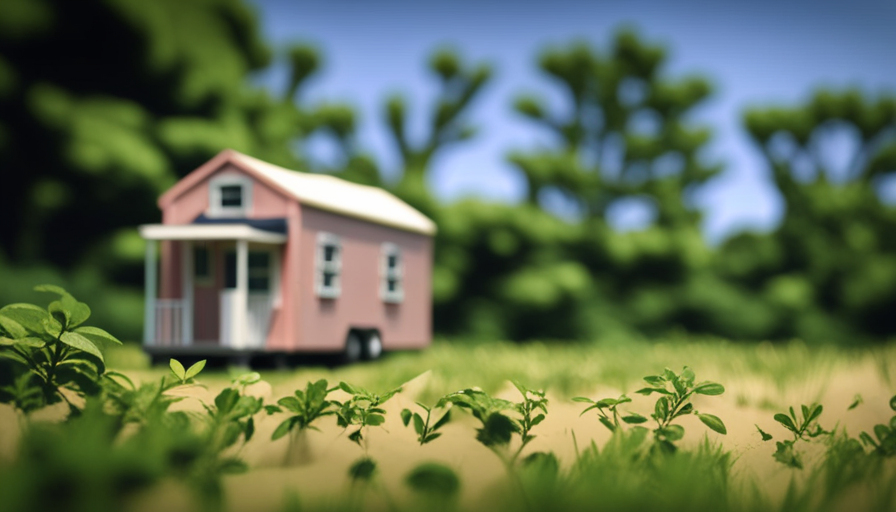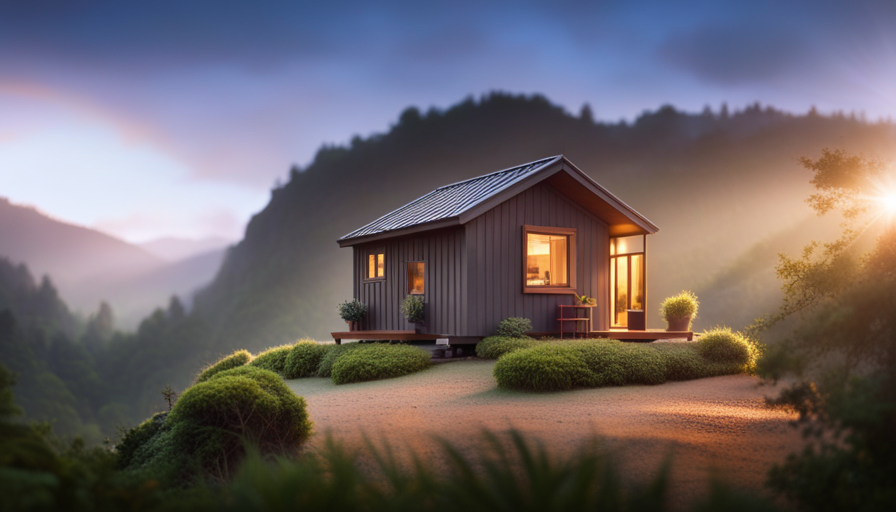Have you ever wondered about the largest size a tiny house can be on Long Island? Get ready to be surprised because the answer may exceed your expectations. In this article, I will walk you through the regulations, zoning laws, and requirements needed to build and live in a tiny house on Long Island.
We will delve into the definition of a tiny house and uncover the specific dimensions that are allowed in this area. But that’s not all! We will also discuss finding suitable land, designing and building your tiny house to meet Long Island’s requirements, and the pros and cons of living in such a compact space.
So, if you’re ready to embrace a minimalist lifestyle and discover the ins and outs of tiny house living on Long Island, let’s dive in!
Key Takeaways
- Tiny houses on Long Island typically range from 100 to 400 square feet in size.
- Regulations and zoning laws for tiny houses on Long Island vary depending on the specific town or village, with some areas classifying them as Accessory Dwelling Units (ADUs).
- Suitable land for a tiny house should be zoned for residential use and have convenient access to amenities.
- Designing and building a tiny house on Long Island requires adherence to local building codes and regulations, which may require professional consultation.
Understanding the Definition of a Tiny House
So, how big does a tiny house have to be on Long Island? To understand the answer, we must first define the characteristics of a tiny house.
A tiny house is a small, compact dwelling that typically ranges from 100 to 400 square feet in size. Its defining characteristics include efficient use of space, minimalistic design, and a focus on sustainability. The benefits of living in a tiny house include lower costs, reduced environmental footprint, and the ability to live a simpler, clutter-free lifestyle. However, there are also challenges to consider, such as limited storage space and the need to downsize belongings.
Moving on to regulations and zoning laws for tiny houses on Long Island, it is important to note that these factors play a significant role in determining the size and placement of a tiny house.
Regulations and Zoning Laws for Tiny Houses on Long Island
To comply with regulations and zoning laws on Long Island, you’ll need to ensure your tiny dwelling meets the specific size requirements set by the local authorities. These regulations vary depending on the specific town or village you plan to build your tiny house in.
For example, in some areas, a tiny house may be classified as an Accessory Dwelling Unit (ADU) and must comply with the size restrictions for ADUs, which typically range from 300 to 600 square feet. Additionally, there may be rules regarding setbacks, height restrictions, and minimum lot sizes.
It’s crucial to thoroughly research and understand the regulations and zoning laws of the specific area you intend to build in to avoid any legal issues. Once you have a good grasp of the regulations, you can start finding suitable land and location for your tiny house.
Finding Suitable Land and Location for Your Tiny House
Finding the perfect plot of land for your cozy abode involves envisioning a picturesque location with breathtaking landscapes and a tranquil atmosphere. When it comes to finding suitable land for your tiny house on Long Island, there are a few factors to consider. Here are some key points to keep in mind:
-
Location: Look for land that’s conveniently located near amenities such as grocery stores, schools, and healthcare facilities.
-
Zoning regulations: Ensure that the land is zoned for residential use and allows for tiny houses.
-
Accessibility: Consider the accessibility of the land, including road access and utilities such as water and electricity.
-
Financing options: Explore different financing options available for purchasing land, such as loans or lease-to-own agreements.
-
Environmental considerations: Take into account any environmental factors, such as flood zones or protected areas, that may affect the suitability of the land.
Now that you’ve found the perfect location, it’s time to delve into designing and building a tiny house that meets Long Island’s requirements.
Designing and Building a Tiny House to Fit Long Island Requirements
Once you’ve secured the perfect location on Long Island, it’s time to design and build your tiny dream home that meets all the necessary requirements, ensuring that it’s both functional and aesthetically pleasing.
Did you know that the average size of a tiny house is around 400 square feet, making it a cozy and efficient living space?
When designing and building your tiny house on Long Island, it’s crucial to adhere to the local building codes and regulations. These codes specify the minimum requirements for construction, including safety standards, electrical wiring, plumbing, and more. It’s important to consult with a professional architect or builder who’s familiar with these codes to ensure compliance.
Additionally, financing options for building a tiny house on Long Island may differ from traditional home financing. Exploring alternative financing methods, such as personal loans or crowdfunding, can help make your tiny house dream a reality.
Now, let’s delve into the pros and cons of living in a tiny house on Long Island.
Pros and Cons of Living in a Tiny House on Long Island
Living in a tiny house on Long Island can offer a unique and simplified lifestyle, but it also comes with its own set of challenges.
One of the major advantages is the reduced cost of living. With a smaller space, utility bills and maintenance costs are significantly lower. Additionally, the environmental impact of living in a tiny house is minimal. The smaller size means less energy consumption and a smaller carbon footprint.
However, there are drawbacks to consider. The limited space can feel cramped, especially if you have a family or pets. Storage can be a challenge, and it requires careful organization and decluttering.
Despite these challenges, embracing a minimalist lifestyle can be rewarding. Downsizing allows you to focus on what truly matters and live a more intentional and fulfilling life. Transitioning to a smaller space requires careful planning and a willingness to let go of unnecessary possessions.
Essential Tips for Downsizing and Embracing a Minimalist Lifestyle
When it comes to downsizing and embracing a minimalist lifestyle, you’ll need to start by decluttering your belongings and getting rid of anything that doesn’t bring you joy or serve a purpose. This can be a daunting task, as it requires making tough decisions about what to keep and what to let go of. However, by following some essential tips, you can make the process easier and more manageable.
One challenge of downsizing is finding creative storage solutions for your remaining belongings. Utilizing multi-functional furniture, such as a bed with built-in drawers or a coffee table with hidden storage, can help maximize space. Additionally, incorporating minimalist decor ideas, such as neutral colors, clean lines, and open shelving, can create an illusion of a larger space.
| Challenge | Solution |
|---|---|
| Limited storage space | Utilize multi-functional furniture |
| Feeling overwhelmed | Break down the process into smaller tasks |
| Letting go of sentimental items | Take photos or create a memory box |
By implementing these downsizing strategies and embracing a minimalist lifestyle, you can create a more organized and clutter-free living environment. This will not only make your tiny house on Long Island feel more spacious, but it will also bring a sense of peace and tranquility to your daily life. In the next section, we will explore resources and support available for those interested in living in a tiny house on Long Island.
Resources and Support for Tiny House Living on Long Island
After learning about essential tips for downsizing and embracing a minimalist lifestyle, I’m now eager to explore the resources and support available for tiny house living on Long Island. As someone interested in this alternative way of living, I want to understand how to navigate the local landscape and find like-minded individuals.
One important aspect is the presence of tiny house communities, where residents can connect and share experiences. Additionally, I’m curious about the financial considerations of living in a tiny house on Long Island. Are there any grants or loans available to support this lifestyle choice? Understanding the financial implications will help me make an informed decision and plan for the future.
By delving into these resources and financial considerations, I hope to gain a comprehensive understanding of what it takes to live in a tiny house on Long Island.
Frequently Asked Questions
Can I legally park my tiny house on wheels in my backyard on Long Island?
Yes, legally parking a tiny house on wheels in my backyard on Long Island is subject to parking regulations and zoning restrictions. These regulations and restrictions determine whether a tiny house can be parked on residential properties, the required setbacks from property lines, and any size limitations. It is crucial to research and comply with these regulations to avoid any legal issues. Consulting with local authorities or zoning boards can provide specific information regarding parking requirements for tiny houses on wheels.
What are the average costs associated with designing and building a tiny house on Long Island?
Building a tiny house on Long Island involves various costs, from design to construction. On average, the design process can range from $500 to $5,000, depending on complexity and customization.
Building costs typically start around $20,000, but can go up to $100,000 or more, depending on materials and finishes. These expenses include permits, labor, materials, and utilities.
It’s crucial to carefully budget and plan to ensure a successful and cost-effective tiny house project.
Are there any specific requirements or restrictions for the size of a tiny house on Long Island?
Specific requirements and restrictions for the size of a tiny house on Long Island depend on the local zoning and building codes. These regulations may vary across different towns and municipalities.
However, it’s important to note that tiny houses are typically limited in size to ensure they meet safety and structural standards. Thus, it’s crucial to research and comply with the specific requirements and restrictions set by the local authorities when building a tiny house on Long Island.
How can I find suitable land to park or place my tiny house on Long Island?
To find suitable land for my tiny house on Long Island, I need to navigate zoning regulations. Firstly, I can consult the local zoning office to understand the specific requirements for tiny house placement. It’s crucial to ensure that the land I choose is zoned appropriately and permits tiny houses.
Additionally, I can explore online platforms or contact real estate agents specializing in tiny house properties. By doing thorough research and understanding the regulations, I can locate the perfect spot for my tiny house on Long Island.
What are the potential challenges or drawbacks of living in a tiny house on Long Island compared to a traditional home?
Living in a tiny house on Long Island has its challenges compared to a traditional home. One potential drawback is the limited space, which may require creative storage solutions and minimalistic living.
Additionally, zoning regulations and building codes can pose obstacles when finding suitable land for your tiny house.
Furthermore, designing and building a tiny house on Long Island can be costly, with average costs ranging from $20,000 to $150,000, depending on the size and customization of the home.
Conclusion
In conclusion, living in a tiny house on Long Island is the epitome of freedom and simplicity. With regulations and zoning laws in place, finding suitable land and location is a breeze. Designing and building a tiny house that meets Long Island requirements is a technical challenge, but the rewards are immense.
Embracing a minimalist lifestyle allows you to truly appreciate the beauty of the island. So, if you’re ready to downsize and experience the joy of tiny living, Long Island is waiting for you with open arms. Get ready for the adventure of a lifetime!
Hi, I’m Emma. I’m the Editor in Chief of Tiny House 43, a blog all about tiny houses. While tree houses are often associated with childhood, they can be the perfect adult retreat. They offer a cozy space to relax and unwind, surrounded by nature. And since they’re typically built on stilts or raised platforms, they offer stunning views that traditional homes simply can’t match. If you’re looking for a unique and romantic getaway, a tree house tiny house might just be the perfect option.
















